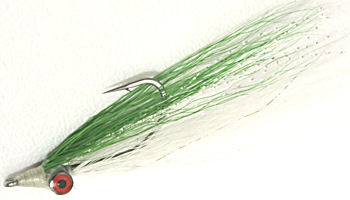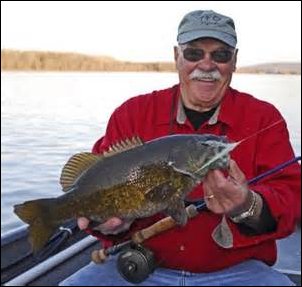Green & White Clouser's Deepwater Minnow
Clouser’s Deepwater Minnows fishing flies are ideal at imitating a number of different small slender baitfish like smelts, Sand lance, Silversides and Anchovies

INVERTED HOOK PATTERNS. Hook size 2, 4, 6, 8 - $US each
The Green and White Clouser's Deepwater Minnow is a good fly fishing pattern to catch largemouth bass. A change in wind speed or direction can effect a Largemouth bass’s feeding activity and location. Subtle local environmental alterations are often missed by fly fishermen. They should learn to look for them as often the best takes can occur directly after a wind shift. Some view the wind as their enemy when they should be working out how to use it to their advantage.
The amount of light penetrating the water decreases when the wind stirs up or agitates the surface. This encourages the large mouth bass to move to areas with more shallow water to feed. Wind that is blowing against a shore line or river bank can create new feeding opportunities. You will find these hungry predators cruising the edges of mudlines formed because of the stirring and eroding action that the wind has on the water. They are looking for crawfish and baitfish that are searching for cleaner water.

This is Bob Clouser the designer of the Clouser's Minnow
Wind that blows against a rock, fallen tree trunk, jetty, clumps of aquatic grass or reeds, or a projection of land, moves the water and creates a micro current in that particular area. The crease between the slack water behind the obstruction and the faster water is a favourite feeding location. Also plankton blown against it starts to build up which concentrates small baitfish and crawfish. This attracts the Bass who take up position alongside it or in nearby cover. They are waiting for their next meal to get within easy striking distance. Cast your Clouser’s Minnow into the wind and work it past these windy day bass holding points. Wait for the take.
In the summer, look out for a good stiff wind blowing surface water into a clump of lily pads. The vegetation normally reduces the rate of the current in the local area and therefor it is slightly stagnate when compared with more open water. The incoming wind re-oxygenates the water which encourages the bigger largemouth’s to move into this zone to hunt for smaller fish who have moved into the same area to look for their food. The reverse can be true in winter or early spring when the water is cooler. A strong cold wind will drive the bass deeper. They normally only come up near the surface to feed if the sun comes out and warms the upper layers.
Tidal changes alter the direction of flow of the water current and the bass have to move to adapt to these new condition. Many Bass fly fishermen miss these subtle changes and do not adapt their approach and suddenly wonder why the fish are not biting anymore. There are two things you can do; buy a local tide book or be more observant. Fish that were watching shallow flats are now concentrating on a ditch or drop off. Bass have learnt to hang around the down current side of a clump of vegetation as the tidal flow empties these green beds of crustaceans and baitfish who now seek deeper water. If you miss these changes you will end up casting to areas that are now devoid of prey and predator.
CLOUSER'S MINNOWS CATCH SEATROUT
Around the foreshores of England and parts of Europe there are places where sea-trout, the sea-run version of the Brown trout, can be caught on the fly in late spring and early summer. Like many other anglers, I first used traditional river seatrout flies that I had had great success with on rivers. I started to lose too many fish through broken hooks. It was not because I had used cheap hooks. It was because I was using freshwater hooks in the salty sea. Rust is a big problem in salt water conditions. It attacks the point, barb, bend and eye of a freshwater hook and weakens them. You can sometimes see the rust but it can often go un-noticed underneath the fly’s dressing. Hooks thus weakened are particularly liable to break when playing good large fish. Just what you do not want to happen.
So what is the answer? If you tie your own flies then you can use saltwater stainless steel hooks and dress them in traditional sea-trout patterns. My preferred and most successful tactic for fishing sea-trout in the sea is to use a Clouser’s deepwater minnow on a saltwater hook. It is an inverted hook pattern so does not get stuck in the bottom. The weighted eyes flip the hook on its back during the retrieve. That is why the light colour fibres that represent a bait fish’s tummy are tied on the top of the hook shank and the darker colour is tied under the shank and over the bend in the hook. The fly is relatively thinly dressed with a long tail that goes over the bend in the hook. This allows the tail to wiggle naturally as it is retrieved through the water and imitate the swimming motion of a long thin saltwater bait fish.
The use of rolled teal, widgeon, speckled ginger bantam or bronze mallard to form the wings of traditional sea-trout flies is great to hint at the speckled flanks and barred sides of small freshwater juvenile fish that are taken by the larger returning sea-trout if they get too close. You do not find these baby fish in the sea. This is why I prefer using a cleaner dressed fly like the Clouser’s minnow to imitate small saltwater fish.
It is hard to know what sea-trout are looking for in their food or causes them to attack. Many fish go for creatures that are injured. They deem them to be easier prey. If sea-trout find your fly body too ornamental they will ignore it. Sometimes the more simpler dressed fly succeeds over more complex designs. This is why I like the Clouser’s minnow. The silver hook, airy hackle and unruly wing give just a hint of good food combined with sufficient injured demeanour to inspire aggression. It does not contain any design feature so obviously un-natural that it should appear repulsive or frightening. I heard an interesting suggestion as to why some flies were given the name Doctor from a friend of mine who works in the medical profession. Doctors and nurses who work in Accident and Emergency units or operating theatres wear very little clothing under their hospital gowns because the room temperature is always warm and they get the odd splashes of bodily fluids and have to change regularly. They can be said to be thinly dressed. Many of the fishing flies with these medical names are thinly dressed with the bare essentials of material to hint at a number of forms of underwater life without attempting to copy any particular type.
CUSTOMER'S COMMENT
I fly fish the Little Miami River just south of Dayton in Ohio, USA and find that one of my most productive flies in the early part of the season when water levels are high is the Green and White Clouser's Minnow. It gets down fast and reduced foul ups as the hook rides up not down. John Draper
CUSTOMER'S COMMENT - CLOUSER'S MINNOWS CATCH LARGE & SMALLMOUTH BASS
If the Largemouth and Smallmouth bass will not come to the surface to attack your great deerhair bass bugs I go deep and get them with a streamer. My
favorite weapon of choice is a Bob Clouser’s Deepwater Minnow. Yes I know Bass feed heavily on Crayfish but a streamer will also catch great Bass. When I have spooned a bass I have found that they have been eating crayfish and Baitfish at the same time. When ever the water is clear and shallow I use the green and white Clouser and in deeper water the Chartreuse and white Clouser. Dave MacGregor, Tennessee


Fly Fishing books

